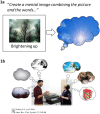Brightening the Day With Flashes of Positive Mental Imagery: A Case Study of an Individual With Depression
- PMID: 28152198
- PMCID: PMC5412934
- DOI: 10.1002/jclp.22455
Brightening the Day With Flashes of Positive Mental Imagery: A Case Study of an Individual With Depression
Abstract
This article presents a case example of an individual with current major depression engaging in a positive mental imagery intervention, specifically a computerized cognitive training paradigm involving repeated practice in generating positive imagery in response to ambiguous scenarios. The patient's reported experience of the intervention suggests the potential of the positive imagery intervention to "brighten" everyday life via promoting involuntary "flashes" of positive mental imagery in situations related to the scenarios, with associated beneficial effects on positive affect, future expectations, and behavior. Enhancing this aspect of the training-i.e., involuntary positive imagery in contexts where it is adaptive-may hold particular promise for reducing anhedonic symptoms of depression. Developing simple computerized interventions to increase the experience of positive mental imagery in everyday life could therefore provide a useful addition to the drive to improve treatment outcomes.
Keywords: anhedonia; cognitive bias modification; depression; involuntary memories; mental imagery.
© 2017 Wiley Periodicals, Inc.
Figures


Similar articles
-
Inducing positive involuntary mental imagery in everyday life: an experimental investigation.Memory. 2020 Oct;28(9):1157-1172. doi: 10.1080/09658211.2020.1822413. Epub 2020 Sep 27. Memory. 2020. PMID: 32985372 Clinical Trial.
-
Imagining a brighter future: the effect of positive imagery training on mood, prospective mental imagery and emotional bias in older adults.Psychiatry Res. 2015 Nov 30;230(1):36-43. doi: 10.1016/j.psychres.2015.07.059. Epub 2015 Jul 21. Psychiatry Res. 2015. PMID: 26235478 Free PMC article.
-
A single case series of imagery rescripting of intrusive autobiographical memories in depression.J Behav Ther Exp Psychiatry. 2023 Dec;81:101854. doi: 10.1016/j.jbtep.2023.101854. Epub 2023 Mar 20. J Behav Ther Exp Psychiatry. 2023. PMID: 37023522
-
Harnessing emotional mental imagery to reduce anxiety and depression in young people: an integrative review of progress and promise.Lancet Psychiatry. 2021 Sep;8(9):836-852. doi: 10.1016/S2215-0366(21)00195-4. Lancet Psychiatry. 2021. PMID: 34419188
-
Integrating mental imagery and fascial tissue: A conceptualization for research into movement and cognition.Complement Ther Clin Pract. 2020 Aug;40:101193. doi: 10.1016/j.ctcp.2020.101193. Epub 2020 Jul 9. Complement Ther Clin Pract. 2020. PMID: 32891273 Review.
Cited by
-
Prospective Mental Images: A Transdiagnostic Approach to Negative Affectivity and Mood Dysregulation among Borderline Personality Disorder and Depression.Behav Sci (Basel). 2024 Jan 23;14(2):81. doi: 10.3390/bs14020081. Behav Sci (Basel). 2024. PMID: 38392434 Free PMC article.
-
The effect of positive mental imagery versus positive verbal thoughts on anhedonia.Appl Psychol Health Well Being. 2025 Feb 25;17(1):e12626. doi: 10.1111/aphw.12626. Epub 2024 Nov 18. Appl Psychol Health Well Being. 2025. PMID: 39558569 Free PMC article.
-
Computerized positive mental imagery training versus cognitive control training versus treatment as usual in inpatient mental health settings: study protocol for a randomized controlled feasibility trial.Pilot Feasibility Stud. 2018 Aug 4;4:133. doi: 10.1186/s40814-018-0325-1. eCollection 2018. Pilot Feasibility Stud. 2018. PMID: 30123524 Free PMC article.
-
Affect and Incident Participation Restriction in Adults With Knee Osteoarthritis.Arthritis Care Res (Hoboken). 2018 Apr;70(4):542-549. doi: 10.1002/acr.23308. Epub 2018 Feb 18. Arthritis Care Res (Hoboken). 2018. PMID: 28686817 Free PMC article.
-
Demonstration of a 'leapfrog' randomized controlled trial as a method to accelerate the development and optimization of psychological interventions.Psychol Med. 2023 Oct;53(13):6113-6123. doi: 10.1017/S0033291722003294. Epub 2022 Nov 4. Psychol Med. 2023. PMID: 36330836 Free PMC article. Clinical Trial.
References
-
- Beck, A. T. , Steer, R. A. , & Brown, G. K. (1996). Manual for the Beck Depression Inventory‐II. San Antonio, TX: Psychological Corporation.
-
- Berntsen, D. , Staugaard, S. R. , & Sørensen, L. M. T. (2013). Why am I remembering this now? Predicting the occurrence of involuntary (spontaneous) episodic memories. Journal of Experimental Psychology: General, 142, 426–444. doi:10.1037/a0029128 - DOI - PubMed
-
- Blackwell, S. E. , Browning, M. , Mathews, A. , Pictet, A. , Welch, J. , Davies, J. , … Holmes, E. A. (2015). Positive imagery‐based cognitive bias modification as a web‐based treatment tool for depressed adults: A randomized controlled trial. Clinical Psychological Science, 3, 91–111. doi:10.1177/2167702614560746 - DOI - PMC - PubMed
-
- Blackwell, S. E. , & Holmes, E. A. (2010). Modifying interpretation and imagination in clinical depression: a single case series using cognitive bias modification. Applied Cognitive Psychology, 24, 338–350. doi:10.1002/acp.1680 - DOI
-
- Blackwell, S. E. , Rius‐Ottenheim, N. , Schulte‐van Maaren, Y. W. M. , Carlier, I. V. E. , Middelkoop, V. D. , Zitman, F. G. , … Giltay, E. J. (2013). Optimism and mental imagery: A possible cognitive marker to promote wellbeing? Psychiatry Research, 206, 56–61. doi:10.1016/j.psychres.2012.09.047 - DOI - PMC - PubMed
Publication types
MeSH terms
LinkOut - more resources
Full Text Sources
Other Literature Sources

